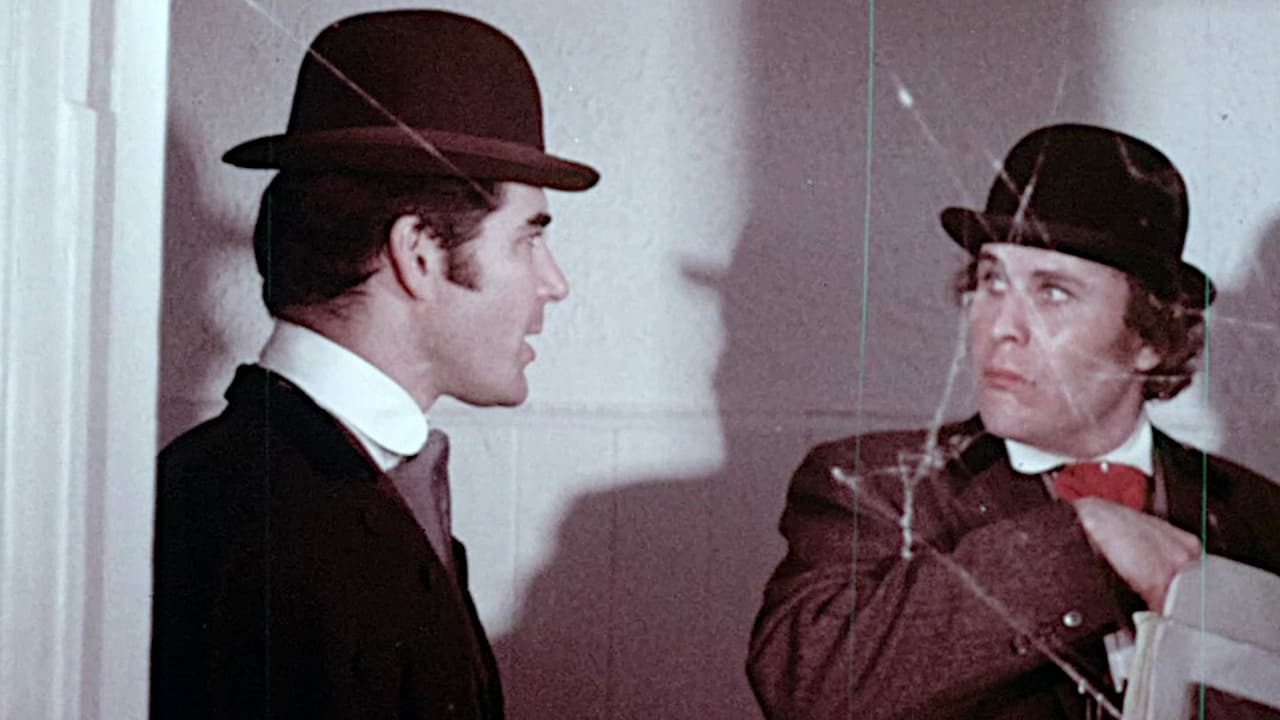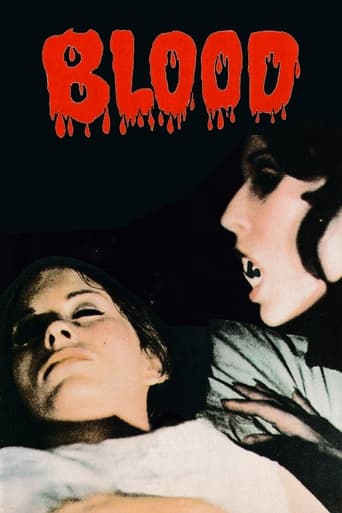

Blood (1974) ** (out of 4)Downright craziness from director Andy Milligan has Lawrence Talbot working under the last name Orlovsky. He moves his wife, the daughter of Dracula, into a house where he also brings along a wide range of weird people. Inside the house he is growing plants, which will eat humans but there are more dark secrets within these walls.Milligan has a huge cult following and it's really easy to see why. I've gone through a hand full of the director's films and for the most part I've found them ranking from downright horrid to suicide worthy. With that said, BLOOD is probably the best film I've seen from him because of how crazy and bizarre it is. I'm not sure if the director just figured he'd throw everything into a film and see what would stick but you've got a werewolf, Dracula's daughter, a deformed mutant and of course the man-eating plants.There are some really kooky moments throughout this thing ranging to some bizarre dialogue where the wife wants to know if her husband still loves her to a werewolf attack that is filmed in such dark conditions that you can't even see what is happening. The melodrama that Mulligan adds to a lot of his horror pictures is something that actually works here because of the fact that it's a werewolf and a vampire. The added supporting of the other freaks is just a good bonus.The performances really aren't all that bad and the film has a much more professional look that the majority of the director's work. At just under 70 minutes the movie manages to keep your interest throughout.
... View MoreThough one of the more notable directors to come from Minnesota, you will not very often hear Andy Milligan mentioned in the same breath as the Coen brothers. In his book Danse Macabre, Stephen King refers to Milligan's first horror film, The Ghastly Ones (1968), as "the work of morons with cameras," and furthermore that a film of that sort is the "staged equivalent of...'snuff' movies." In truth it is difficult to defend Milligan's work on artistic and aesthetic grounds. The inept cinematography makes his grotesque horror stories look like home movies gone horribly wrong. Simple concepts like lighting and framing are alien to Milligan, whose films can feature whole sequences of confused darkness. The chief pleasure for any cineaste checking out Milligan's work might then be to laugh at its failings; in other words, to enjoy it as "so bad it's good" cinema. Being a pretentious asshole, though, I believe that this attitude can often arise from an unwillingness to engage with a film on its own terms. More specifically, it seems to be that traditionally "bad" cinema is usually dismissed for its failure to correspond with one's fixed idea of what a film (or a specific genre, in this case horror) should be. If someone believes these films are bad, their opinion is certainly valid. I'm merely suggesting that the opposite opinion is equally valid, and that traditionally "bad" films can offer a legitimate alternative to classically "good" cinema.With that rambling intro out of the way, I will attempt to defend my own enthusiasm for what I've seen of Milligan's work. Blood is only my second Milligan viewing after my positive experience with The Ghastly Ones. This film, though more technically proficient than that earlier work, is still light years away from the studio gloss we're accustomed to (or even from the threadbare stylistics of Jess Franco). I find Milligan's naiveté behind the camera to be fascinating and educational, in this respect. Completely ignorant of proper filming and editing conventions, it's as if he is forced to invent his own concept of cinema. In reality he was apparently inspired by the avant-garde films of Andy Warhol, so his ignorance may have been willful. If I'm also to be frank, I'd much rather watch a shoddily filmed story of vampires, werewolves, and family dysfunction than the more respected film experiments of Warhol.In the case of both Milligan films I've watched, the chief pleasure is actually derived from the screenplay. Milligan was both a misogynist and misanthropist, and his real-life mean streak serves as the lifeblood of his stories. If there is a married couple in Andy Milligan's work, you can be sure that they despise and/or abuse each other. If they're happily married, they won't remain that way for long. The wife and husband in this film (Dracula's daughter, Regina, and Dr. Lawrence Orlofski, a werewolf) maintain a strained relationship. Regina is convinced that Lawrence is in love with his assistant, Carrie. She says that she loves him, and pleads with him to make love to her. After he refuses, she tells him to go to hell. His deadpan response: "We're there already." In these tales of dysfunctional relationships, the Gothic trappings (a violent werewolf attack, gory hatchet murders, and giant carnivorous plants) are mere window-dressing. Milligan's real interest lies in espousing his hateful world view. These horrific elements mostly serve to make the films salable.At a running time of 57 minutes, Blood hardly has time to overstay its welcome, though many bored internet reviewers would disagree with me. I enjoyed the darkly humorous barbs traded by the film's loathsome cast of characters. The shoddy make-up and set dressing also lend the film a unique, handmade charm, as if you're watching an elaborate home movie made by your deeply disturbed grandpa. For instance, the film is set in the late 1800's, yet the protagonist's house (Milligan's own in real life) clearly has modern plumbing and light fixtures. The actors perform their hateful dialogue with such relish, though, that you can easily forgive these oversights. Likewise, many of these roles are played with such deliberate camp that sophisticated make-up jobs would almost feel wrong.There is plenty else to chew on here, such as the fact that Dr. Orlofski (is this a reference to Franco's Dr. Orlof?) is really named Talbot (i.e. Lawrence Talbot, Universal's tragic wolf man); the hierarchy of abuse in the Orlofski household; and just how the hell those carnivorous plants benefited Regina in any way (they supposedly help to treat her vampirism). Since I'm not getting paid to write this I'll leave those thoughts for another day.
... View MoreWell, here's my first Andy Milligan film, and I'm feeling fairly indifferent about it, even though I fully knew what to expect. A strange family move into a new home. The husband is some sort of doctor working on various serums from carnivorous plants. His wife has an aversion to sunlight and needs constant injections. One of their servants is used as a blood bank to feed the plants and is all messed up due to this, and of the other two servants, one has no legs and the other is well on the way to having no legs due to some horrible disease.The doctor meets his solicitor who's up to something dodgy with his dead father's estate, and also he falls in love with the solicitor's secretary. All this leads to, mainly, is people standing around in period costumes, talking endlessly. This film was under an hour long and I still had to watch it over two nights just to keep my attention.There's werewolves, vampires, man-eating plants, people getting axed through the head, but everything to me seemed a bit flat and boring. Also, it looked like someone killed a mouse for real at one point – that's no good, is it? I'm not writing Milligan off yet – I've got Guru the Mad Monk to watch too – I'll give that a chance soon.
... View MoreThis is one of Milligan's better Gothic style horror dramas. It's a lot in the style of THE RATS ARE COMING!THE WEREWOLVES ARE HERE! But not as dull. The acting is much better than in most of his films and the camera work is not bad.The film does have two strikes against it. 1)When the wolf man turns into a werewolf he is wearing a silly looking werewolf mask and 2)The action scenes seem to being missing something as if something was cut out. This is how most of Milligan's films seem to be edited though so I can't tell if I was watching a censored print or if it was edited that way.
... View More